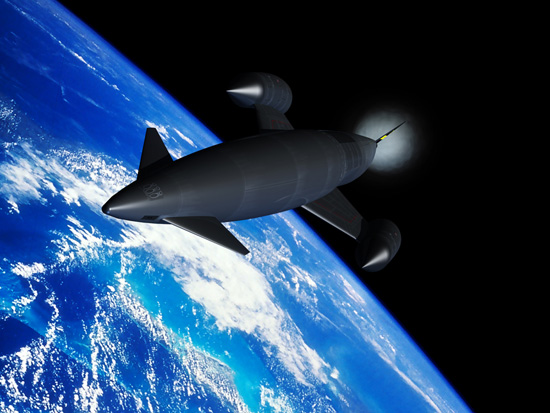Today to get people and payload to Earth orbit and beyond, a huge rocket burning tons of dangerous fuels at great expense in necessary. If the human race is ever going to seriously explore and exploit space we are going to have to find a much cheaper, more efficient and easier way to send people and things into orbit and beyond. The Chinese are working on a "spaceplane" that could accomplish these goals.
The China Aerospace Science and Technology Corporation (CATSC) is developing a hybrid plane and spacecraft that will be able to take off from a runway like a conventional plane and then ascend all the way to Earth orbit. It will be able to reverse the journey and descend from orbit to land on a runway. The spaceplane will be able to be checked and refueled quickly to be used again. This reusability will substantially reduce the cost of reaching Earth orbit. The combined cycle engine will propel the spaceplane more slowly than a conventional rocket launch. The journey to space will be much less stressful and will not subject the passengers to the brutal G forces of a conventional rocket launch.
When the spaceplane takes off from the runway, it will be powered by a conventional turbofan or turboprop engine. Then a ramjet will take over to carry the spaceplane up through the atmosphere. When the spaceplane achieves supersonic velocity, it will change over to a scramjet engine that will send it from twelve miles to about sixty miles altitude which is considered to be the edge of space. When the spaceplane reaches the edge of space, it will use a rocket engine to raise it into Earth orbit.
The Chinese spaceplane which is being referred to as a "hypersonic shuttle" will be developed over the next three to five years. They are leading the field in research on the type of combined cycle engines that will be required for the hypersonic shuttle. However it will still be a serious challenge to integrate all these different propulsive capabilities into a single engine. A second big challenge will be to develop an airframe that is light enough to be economical and strong enough to withstand the stress of hypersonic flight and reentry from orbit. The Chinese hope to be able to put the hypersonic shuttle into regular service by 2030.
The British are working on a similar spaceplane concept called the Skylon. It will rely on a new technology that will super cool the air intakes for the supersonic portion of the flight instead of using a scramjet as in the Chinese design. The British hope to have their Skylon spaceplane ready for regular service around 2030, the same date that the Chinese are working toward.
The U.S. is falling behind in the spaceplane race. If the U.S. does not develop its own hypersonic spaceplane, it will be at a disadvantage in the global space marketplace behind the Chinese and the British. Billions of dollars will be spent on space exploitation in the coming decades and the U.S. will lose out on a great deal of business if they do not have an operating spaceplane.
Artist's concept of British Skylon Spaceplane:
